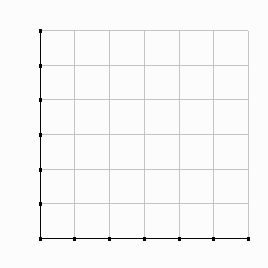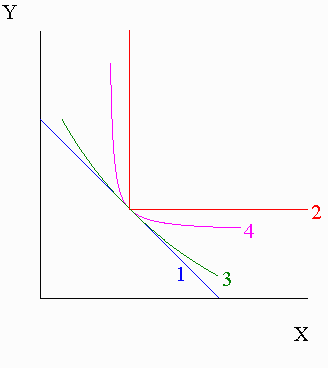II. CONSUMER DEMAND
B. EXTENSIONS AND
APPLICATIONS OF CONSUMER THEORY
2. SUBSTITUTION AND INCOME
EFFECTS
In practice, a price change generally affects you 2
ways. It affects the relative attractiveness of related goods, and it changes your
attainbale level of well-being (your utility).
DP -->
(1) Drelative values (MRS* = Px/Py)
(2) Dreal income(U*)
Both affect consumption of the good whose price has
changed.
--1. Consumption will adjust because of the new optimal value for MRS
--2. Consumption will adjust because of the new level of well-being
Substitution and income effects separate out these
impacts on consumption.
a. BASIC ANALYSIS
A price change affects quantity
demanded because of....
(1) The substitution effect:
the consumption adjustment you make because the new price changes the relative
attractiveness of the goods you buy.
(=> move to new P on original U)
Ex: A lower relative price (of health food=goodX)
makes you tend to substitute health food for junk food (goodY).
Makes the new BL flatter than before, so you move to a flatter part of
any indifference curve you might be on
(2) The income effect:
the consumption adjustment you make because the new price changes your attainable level of
well-being.
(=> move to new U at new price)
For example, when price falls, your greater sense of
well-being prompts you to change your consumption of health food.
Example: you consume two
goods:
Health food (H) and
Junk food (J) (Give Ua a smooth gradual sweep;
this helps to illustrate the two effects clearly.)
Now consider what happens when the price of health
food (Ph) falls, moving consumption to point 'b'.
(To allow plenty of room to work, note that (1) Ph falls quite a bit,
and (2) point 'b' is pretty far over to the right of point 'a'.)
(Make Xb = 8)
|
|
 |
|
(1) THE SUBSTITUTION EFFECT isolates the consumption
adjustment you make because the new price changes the relative attractiveness of the goods
you buy.
(It shows your consumption at the new price but at your original
utility.)
? Which budget line reflects the new
price?
? Which indifference curve reflects
the original utility?
To find the substitution effect, draw
BLa' by sliding BLb back until it is tangent to Ua. (Label the
tangency point as a'; Make Xa'=6)
a --> a' = the substitution effect
(S)
? How large an impact does it have on
the consumption of health food?
(2) THE INCOME EFFECT is the consumption adjustment
you make because the new price changes your attainable level of well-being.
(It shows what happens to consumption as you move to a new indifference
curve at the new price)
To find the income effect, move from
Ua to Ub at the new price.
a' --> b = income effect (I)
? How large an impact does it have on
the consumption of health food?
? Is health food a normal or inferior
good?
? How can you tell?
Summary of possible substitution and income effects:
Px/Py falls: effect on
consumption of X (+/-/0/?):
| |
Normal good |
Inferior good |
| Substitution effect: |
|
|
| Income effect: |
|
|
| Combined effects: |
|
|
Key results: The substitution effect always makes us
consume more of a good when it gets cheaper and less of it when it gets more expensive.
It's the pure version of the 'law of demand'.
The income effect of a lower price makes consumption rise for a normal
good but fall for an inferior good.
Substitution effect: large when good substitutes are
available.
string beans and lima beans
Income effect: large when the budget share of the
product is high.
housing, staple foods for the poor
Good counterexample: salt
No good substitute and a small budget share. Both effects are small, so
demand for salt is very inelastic.
b. APPLICATIONS
Failure to separate substitution and income effects
can lead to some counterintuitive results.
(1) Upward sloping demand curves
(Giffen goods)--How substitution and income effects influence
consumer demand:
The substitution effect
always makes quantity demanded rise when price falls and vice versa.
But the demand curve includes both substitution and income effects. For a normal good, the substitution and income effects
reinforce each other.
So D will slope down
(available online: Substitution
and income effects: alternative possibilities
Worksheet
? True or false: All Giffen goods are
inferior goods, but not all inferior goods are Giffen goods.
Recap:
Necessary conditions for a Giffen good:
1. Inferior good
2. Few subs (=> small sub effect)
3. Large budget share (=> large inc effect)
May be mainly academic, but possibly observed for
rats:
X= quinine water, healthy, but not liked
Y= root beer
P = lever pushes: 1 lever push for X, 2 lever pushes for Y
I = total lever pushes, I held low, so rats were hungry.
Lower Px = more X per push |


|
 |
|
(2) Counterintuitive cross-price
elasticities
Recall, cross-price elasticities tell us whether
goods are substitutes or complements.
We know in fact that the distinction shows up in the shape of
indifference curves, but in practice, when the price of one good changes, we don't stay on
a single indifference curve.
This can cause income and substitution effect problems.
| Ex: Marie
Antoinette ? Did Marie
Antioinette consider bread and cake to be substitutes or complements?
?How did you decide?
Let:
X = Bread (B)
Y = Cake (C)
and start with a relatively low price of bread.
Let the price of bread rise, and consider first the
substitution effect.
? What do we do to show it?
But as utility falls due to the higher price of
bread, consumers will move back down their income consumption curve to reach BLb, and the
income effect will make cake consumption fall if cake is a normal good. |
|
 |
|
Overall:
1 = substitution effect, raising cake consumption.
2 = income effect, lowering cake consumption.
Combined: cake consumption can fall as the price of bread rises.
Substitute and complement
goods actually refer just to the shape of indifference curves.
1 = perfect substitutes
2 = perfect complements
3 = strong substitutes
4 = strong complements
Income effects can obscure these relationships when we try to observe them |
 |
 |
|
Next topic

